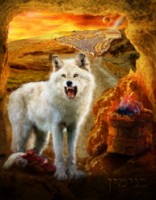 Benjamin / Binyomin בִּנְיָמִין
Benjamin / Binyomin בִּנְיָמִין
What imageries are included in the depiction of Benjamin?
The image of Benjamin depicts the traditional emblem of a ravenous wolf. In the background is the city of Jerusalem with its Temple Mount, which was partly Benjamin’s territory. The setting can also be interpreted as dawn or late dusk, the description of Jacob’s blessings and the additional reference to the altar, which devoured the sacrifices in the morning and in the evening. The reddish hues denote the war-like characteristic of the tribe.
The Meaning of the Name Benjamin
Benjamin was originally named by his mother Ben-Oni, son of my affliction/sorrow as stated in Genesis 35:18. “As she breathed her last—for she was dying—she named her son Ben-Oni. But his father named him Ben Yamin (Benjamin), son of the right hand; that is, of good luck.” The name Benjamin has various meanings. Some say it’s Son of Days, because Benjamin was born to his father in his old age of 100 years. Some interpret the name Benjamin as son of the South, since he was the only son born to Jacob in Palestine; the others having been born in Mesopotamia, north of Palestine. The name Benjamin is also derived from Yemini, Ish Yemini, and Ereẓ Yemini, denoting the people living to the south or right of the Ephraimite highland. Some stress on the meaning of the name, beloved of the L-rd, by which Benjamin is distinguished.
The Biblical Blessings for the Tribe
Jacob’s blessing for the tribe of Benjamin is found in Genesis 49:27. “Benjamin is a ravenous wolf; in the morning he devours the prey, in the evening he divides the plunder.”
Moses’ blessing for Benjamin states: “Let the beloved of the L-rd rest secure in him, for he shields him all day long, and the one the L-rd loves rests between his shoulders (Deut. 33:12).” This is a reference to Benjamin’s excellent locality because his territory was so favorably situated as to give it prominence beyond its numerical proportions. It can also refer to the early ripening of the fruits in the territory of Benjamin, and the great fertility of the region of Jericho and Beth-el.
Tribal Territory
Benjamin was privileged to have the Shekinah dwell in his territory and erect the Temple on Benjamitic ground because all the other tribes had taken part in the selling of Joseph. For G-d said: “If they—the Israelites—build me a Temple in some other place and seek my mercy, I can show them as little mercy as they showed their brother Joseph.” Some claim that the temple was built on tribal land because he neither bowed down before Esau, as did his brothers and father did or before Joseph and that is the reason his territory was reserved for the worship of G-d. According to Joshua 18:11, Benjamin’s assigned territory fell between that of Ephraim/Joseph to the north and Judah to the south, touching the Jordan River on the East, and included many historically important cities, such as Gibeon, Gibeah, Ramah, Mizbeh, Gilgal and Beth-el, lying on the line leading from Jericho to the northern encroaching hills of Jerusalem. The Temple district in Jerusalem has traditionally been said to rest partly in the territory of the tribe of Benjamin (but mostly in that of Judah).
Interesting Notes
Benjamin was the 12th and final son of Jacob; he was born after Joseph was sold into slavery. Benjamin was, next to Joseph, Jacob’s favorite son. Since Joseph was presumed dead, he assumed the status of being Jacob’s beloved son. Joseph and Benjamin were full brothers.
A well-known Benjamite was the nation’s first king—Saul. He reigned from Gibeah for 38 years.